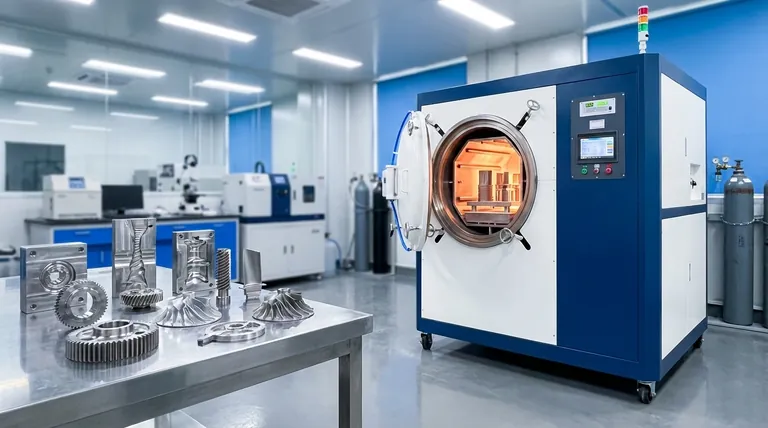At its core, vacuum hardening is used to create exceptionally strong, clean, and dimensionally stable metal components without damaging their surface. It is a high-precision heat treatment process that leverages an oxygen-free environment to harden materials like steel. This prevents the oxidation, scaling, and discoloration common in conventional methods, often eliminating the need for subsequent cleaning or machining.
The primary reason to choose vacuum hardening is not just to harden metal, but to do so with superior control. This results in a pristine surface finish and minimal distortion that is often impossible to achieve with atmosphere-based methods.

The Core Principle: Why a Vacuum Changes Everything
Vacuum hardening isn't simply about heating metal; it's about controlling the entire environment to achieve a superior outcome. The absence of oxygen is the key differentiating factor.
Eliminating Surface Oxidation
In traditional hardening, heating steel in the presence of air (oxygen) causes a chemical reaction that forms a dark, rough layer of scale (oxide) on the surface. A vacuum furnace removes the air, replacing it with an inert gas like nitrogen or simply operating under reduced pressure.
This oxygen-free environment completely prevents surface oxidation, no matter how high the temperature gets (up to 1,300°C).
Achieving a "Bright" Finish
The direct result of preventing oxidation is a part that emerges from the furnace with a bright, clean, metallic surface.
This is a significant economic advantage. Components are often ready for use immediately, eliminating costly and time-consuming secondary operations like sandblasting, grinding, or chemical cleaning.
Precise Temperature and Quenching Control
Vacuum furnaces provide extremely uniform heating, which reduces internal stresses and the risk of the part warping.
The cooling (quenching) phase is also highly controlled. Instead of being plunged into oil or water, the part is cooled by a high-pressure stream of inert gas. The pressure, direction, and flow of this gas can be precisely adjusted to match the part's geometry, ensuring consistent hardness with minimal distortion.
Key Applications and Industrial Benefits
Vacuum hardening is chosen when the final quality and precision of the component are paramount.
High-Performance Engine and Transmission Parts
In the automotive industry, components like gears, shafts, and bearings must endure immense stress and wear.
Vacuum hardening delivers the required durability while ensuring the parts meet tight dimensional tolerances. This reduces the risk of distortion and contamination, leading to more reliable and efficient engines and transmissions.
Tooling, Dies, and Molds
High-value tool steels used to make dies and molds require hardening processes that preserve their intricate surface details and sharp edges.
The process provides exceptional hardness and wear resistance without compromising the finished surface, extending the life and performance of the tool.
Components with Complex Geometries
For parts with complex shapes, thin sections, or tight internal tolerances, uniform heating and controlled cooling are critical.
Vacuum hardening excels here, as it minimizes the risk of warping or cracking that can occur with more aggressive liquid quenches.
Understanding the Trade-offs
While powerful, vacuum hardening is a specialized process. Understanding its limitations is key to using it effectively.
The Benefit: Unmatched Surface Integrity
The primary trade-off is often cost versus quality. While potentially more expensive per cycle than some bulk methods, vacuum hardening can lower the total cost of production by eliminating post-processing steps and reducing scrap rates from distortion.
The Limitation: Quench Severity
While highly controllable, gas quenching is typically less severe than an aggressive oil or water quench.
For some lower-alloy steels that require an extremely rapid cooling rate to achieve full hardness, vacuum hardening may not be the optimal choice. It is best suited for air-hardening or oil-hardening grade materials.
Making the Right Choice for Your Component
To determine if vacuum hardening is the correct process, evaluate your component's most critical requirements.
- If your primary focus is surface finish and avoiding post-processing: Vacuum hardening is the ideal choice, as it produces clean, bright parts directly from the furnace.
- If your primary focus is dimensional stability for complex parts: The uniform heating and controlled gas quenching minimize distortion, making it superior for components with tight tolerances.
- If your primary focus is simply achieving bulk hardness on a simple part: A conventional atmosphere or salt bath process may be more cost-effective, provided you can accommodate the necessary post-treatment cleaning.
Ultimately, choosing vacuum hardening is an investment in final-part quality, precision, and overall process efficiency.
Summary Table:
| Aspect | Benefit of Vacuum Hardening |
|---|---|
| Surface Finish | Bright, clean, metallic surface with no oxidation or scaling |
| Dimensional Stability | Minimal distortion and warping due to uniform heating and controlled gas quenching |
| Process Efficiency | Eliminates need for secondary cleaning, reducing total production cost |
| Ideal Applications | High-performance automotive parts, tooling, dies, and complex geometries |
Ready to enhance your component quality with precision heat treatment?
KINTEK specializes in advanced lab equipment and consumables for material processing. Our vacuum hardening solutions deliver exceptional surface integrity and dimensional stability, reducing your post-processing costs and scrap rates.
Contact us today to discuss how our expertise can optimize your laboratory's efficiency and results!
Visual Guide

Related Products
- Vacuum Heat Treat Furnace with Ceramic Fiber Liner
- Vacuum Heat Treat Furnace and Levitation Induction Melting Furnace
- Molybdenum Vacuum Heat Treat Furnace
- 2200 ℃ Graphite Vacuum Heat Treat Furnace
- 2200 ℃ Tungsten Vacuum Heat Treat and Sintering Furnace
People Also Ask
- How to vacuum out a furnace? A Step-by-Step Guide to Safe DIY Maintenance
- Why do you vacuum for heat treatment? Achieve Flawless, High-Performance Metal Components
- Can I vacuum the inside of my furnace? A Guide to Safe DIY Cleaning vs. Professional Service
- What is a vacuum furnace used for? Unlock Purity in High-Temperature Processing
- What materials are used in a vacuum furnace? Selecting the Right Hot Zone for Your Process



















